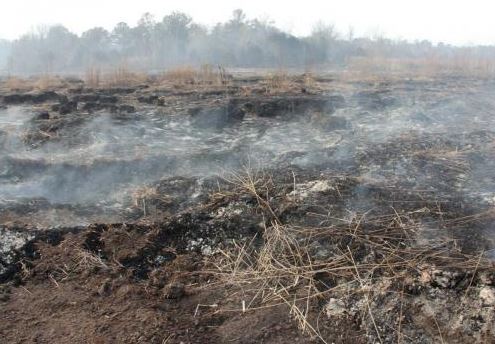
“The scary thing is future climate change may … dry out peatlands. If peatlands become more vulnerable to fire worldwide, this will exacerbate climate change in an unending loop.” Guido R. van der Werf
Six researchers have written a paper about how climate change is expected to increase the number of peat fires worldwide. This is disturbing for a number of reasons, including the health effects of the additional smoke that humans must breathe, and the additional carbon in the atmosphere may “exacerbate climate change in an unending loop.”
The researchers — Merritt R. Turetsky, Brian Benscoter, Susan Page, Guillermo Rein, Guido R. van der Werf, and Adam Watts — all work for universities. Even though the funding was supplied by five government agencies, if you want to read their paper at Nature Geoscience it will cost you between $5 and $32. Open Access is apparently not a priority for the universities and government agencies that are responsible for this important taxpayer funded research. The agencies that funded the research, other than the universities that employ the scientists, are National Science Foundation (NSF), NASA, The European Research Council, the Natural Sciences and Engineering Research Council of Canada, and the Desert Research Institute’s Division of Atmospheric Sciences (the environmental research arm of the Nevada System of Higher Education).
Government agencies should not fund research unless there is a guarantee that the results will be immediately, freely, and easily available on the internet.
Below is an article about their findings, supplied by the Desert Research Institute, the environmental research arm of the Nevada System of Higher Education, the employer of Mr. Watts.
****
The natural disaster plays out like a movie script – ash falling from the sky, thick smoke shutting down airports and businesses across the globe, and uncontrollable fires burning for days and weeks. But this is not from a script; rather, it is a vivid description of a future climate change scenario in which the Earth’s peat-rich regions become more susceptible to drying and burning.
New research published this week in the journal Nature Geoscience, co-authored by Adam Watts, a fire ecologist at Nevada’s Desert Research Institute (DRI) and deputy director of DRI’s Climate, Ecosystems, Fire and Applications Program, outlines the threat of drying peatlands (also known as mires) across the globe and their increased vulnerability to fire and carbon loss.
Peatlands – which make up around three-percent of the Earth’s land surface and store approximately 25-percent of the world’s soil carbon – are deposits of plant material and organic matter mixed with soil that is too wet to support high levels of decomposition. Peatlands are found on all seven continents.
Already the largest fires on Earth in terms of their carbon footprint, these smoldering fires burn through thick layers of peat, built up over thousands of years, which blanket the ground in ecosystems ranging from the tropics to the arctic.
“When people picture a forest fire, they probably think of flames licking up into tree tops, and animals trying to escape,” said the study’s lead author Merritt Turetsky, a professor of Integrative Biology at University of Guelph in Ontario, Canada. “But peat fires tend to be creeping ground fires. They can burn for days and weeks, even under relatively wet conditions. They lack the drama of flames, but they produce a lot of smoke.”
That smoke contains large amounts of carbon and makes peat fires dangerous to human health. It can worsen air quality and even trigger asthma and other respiratory problems.
“In addition to the amount of carbon released, the types of emissions also can make smoldering fires of greater concern than fires where most of the combustion takes place in flames,” said Watts, who is studying the emissions from burning peat and many other types of organic fuels with his DRI colleagues to determine their potential effects in the atmosphere and on our global climate.
“Peat fires are an example of wildfires having effects far beyond the areas where they occur, and these effects can last for a very long time,” he added.
Turetsky and former University of Guelph post-doctoral researcher Brian Benscoter teamed up with temperate and tropical fire scientists to summarize what is known about peat fires, from massive lightning-ignited fires that burn large areas of the boreal region to tropical fires often triggered by human activity.
“The tropical peatlands in Southeast Asia are a clear demonstration of how human activity can alter the natural relationships between ecosystems and fire,” explained Susan Page, a University of Leicester professor and co-author on the study. “Tropical peatlands are highly resistant to natural fires, but in recent decades, humans have drained peatlands for plantation agriculture. People cause the deep layers of peat to dry out, and also greatly increase the number of fire ignitions. It’s a double threat.”
This causes a host of problems, including health issues, airport and school closures, and political tensions.
The paper concludes that almost all peat-rich regions will become more susceptible to drying and burning with a changing climate. The authors also note that the ecology of peat fires and the role of peat fires in long-term Earth system processes need to be explored more thoroughly in future research.
“Thanks to satellite data, we are fully aware of the vast scale of burning in drained peatlands, mostly in Indonesia,” said co-author Guido van der Werf, a professor at Amsterdam’s VU University. “The scary thing,” Werf added,” is future climate change may actually do the same thing: dry out peatlands. If peatlands become more vulnerable to fire worldwide, this will exacerbate climate change in an unending loop.”
This research was supported by the National Science Foundation (NSF), NASA, The European Research Council, the Natural Sciences and Engineering Research Council of Canada, and the Desert Research Institute’s Division of Atmospheric Sciences.
****
